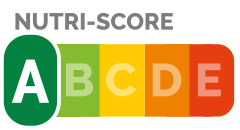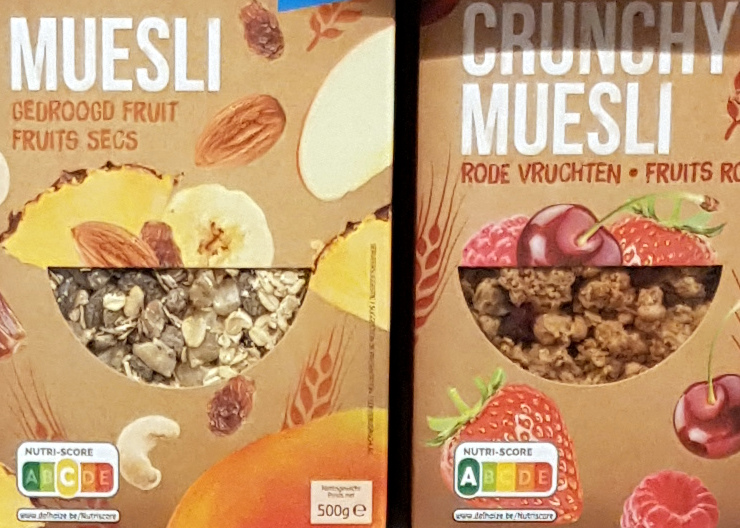Compare the nutrition quality of food products with the Nutri-Score!
What is Nutri-Score?

The Nutri-Score is a logo that shows the nutritional quality of food products with A to E grades. With the NutriScore, products can be easily and quickly compared.
Open Food Facts has started computing Nutri-Score in 2014 on its pioneer mobile app and website, while it was only a research paper, and has accompanied its growth from the "5 color score" to the "Nutri-Score" you see in supermarkets today. However, the Nutri-Score is not affixed to all products and OpenFoodFacts allows you to have this information by scanning the product. Public Health France has supported OpenFoodFacts since 2018 to facilitate consumer information. For more on the history of Open Food Facts and the Nutri-Score, you can read our dedicated page.
Nutri-Score front-of-pack nutrition grade on breakfast cereals in a Delhaize store in Belgium (May 2019)
How is Nutri-Score computed?
The Nutri-Score is calculated from data in the nutritional declaration table which appears on the back of the packaging and composition data (fiber, fruits and vegetables, dried vegetables).
It is determined by the amount of healthy and unhealthy nutrients:
Negative points: energy, saturated fat, sugars, sodium (high levels are considered unhealthy)
Positive points: the proportion of fruits, vegetables and nuts, of olive, colza and nut oils, of fibers and proteins.
The detailed Nutri-Score formula is publicly available on the Santé publique France web site.
A Nutri-Score calculator is available at the following.How can I see the Nutri-Score of food products?
TNutri-Score is a voluntary labeling system. It appears on the label of food products only in some countries and for brands which commited to the score, but it is computed for all products of all countries on Open Food Facts since 2014!
You can see the Nutri-Score of food products with the Open Food Facts iPhone and Android mobile app, and on the Open Food Facts web site. If the product is not yet on Open Food Facts, you can add it in a minute by adding the nutrition facts and selecting a category, and the Nutri-Score will be computed and shown instantly.
Who created the Nutri-Score?
Nutri-Score has been proposed by EREN, a French public nutrition research team, led by Professor Serge Hercberg. It is based on the nutrition score created by the Food Standards Agency in the UK.
The principle of simplified labeling on the front of packaging was officially presented for the first time in the 2013 report "Proposals for a new impetus to the French public health nutrition policy in the framework of the National Health Strategy" (pdf). In it, Professor Serge Hercberg advocates for the adoption of logo with a system of grades from A to E that would be displayed on the front of food products to allow to easily compare the nutritional quality of products.
Which countries have adopted the Nutri-Score ?
The Nutri-Score has been adopted by French public authorities in 2017, and then in Belgium, Switzerland, Germany, Luxembourg and Spain. The Nutri-Score is optional in these countries, but a growing number of food manufacturers are displaying it on their products:
- Brands with Nutri-Score in France
- Brands with Nutri-Score in Belgium
- Brands with Nutri-Score in Spain
- Brands with Nutri-Score in Germany
- Brands with Nutri-Score in Luxembourg
- Brands with Nutri-Score in Switzerland
Research teams in other countries, like Mexico, are also conducting research based on Nutri-Score.
Thank You
We would like to thank Professor Serge Hercberg and Dr. Chantal Julia from the Research Team in Nutritional Epidemiology (EREN) of the Paris 13 University / Avicenne Hospital for their help and the data they have communicated us to compute the nutritional score and the Nutri-Score grades.
Learn more about the Nutri-Score
- Nutri-Score official presentation and Nutri-Score Scientific and Technical FAQ on the web site of the French national public health agency Santé publique France.
- A 2 minutes video : What labeling for food products?
- Avec le Nutriscore, c'est plus facile de manger mieux (in French - Santé Publique France)
- Le dispositif Nutri-Score - Infographie pédagogique (in French - Santé Publique France)
- NUTRI SCORE | Choisissez plus facilement (in French - Santé Belgique)
- NUTRI SCORE | Choisissez plus facilement (in French - Santé Belgique)
- NUTRI-SCORE | Kies gemakkelijker ! (in Dutch - GezondheidBelgie)
- NUTRI-SCORE | Kies gemakkelijker ! (in Dutch - GezondheidBelgie)
- Nutri-Score (in Spanish)
- Petition for a simple, intuitive and understandable by all nutritional labeling on the front of food packages